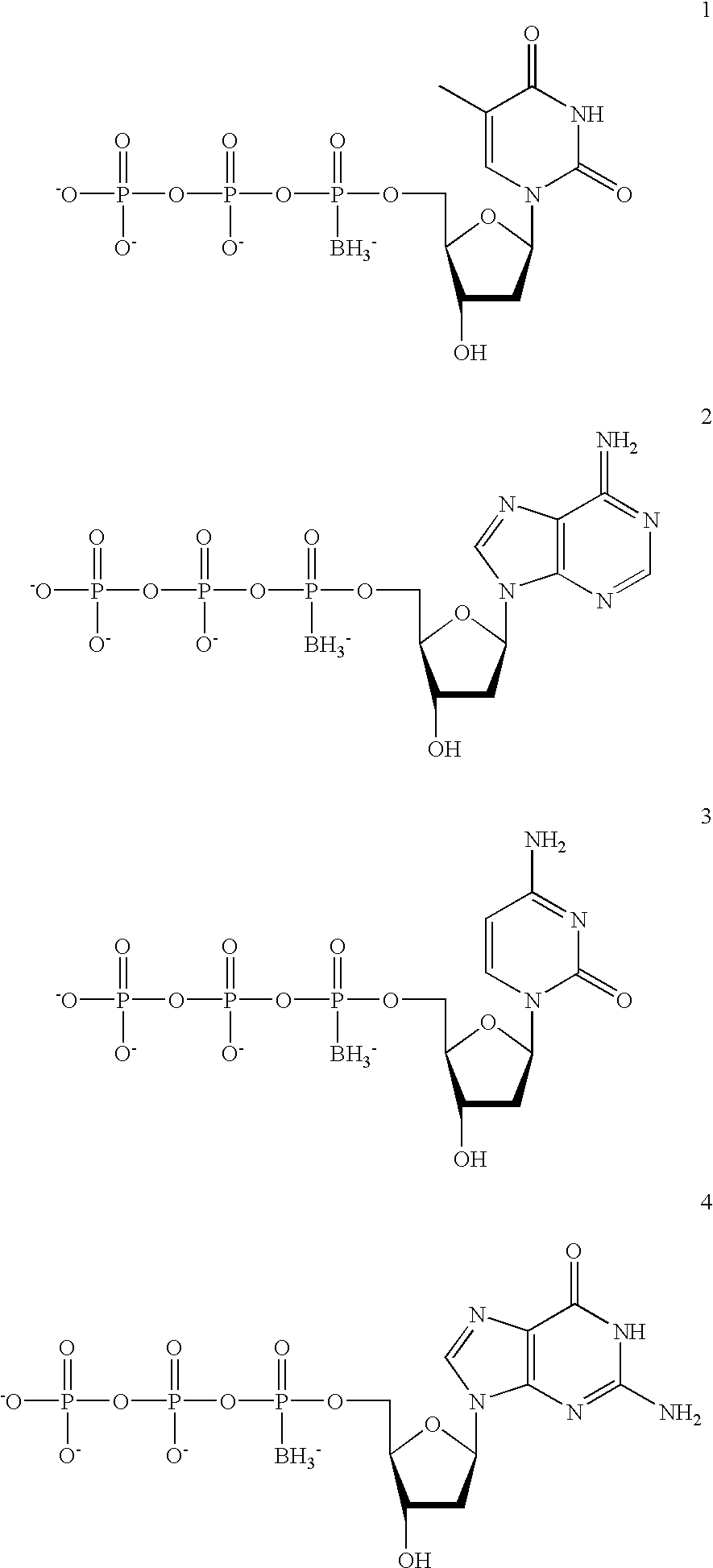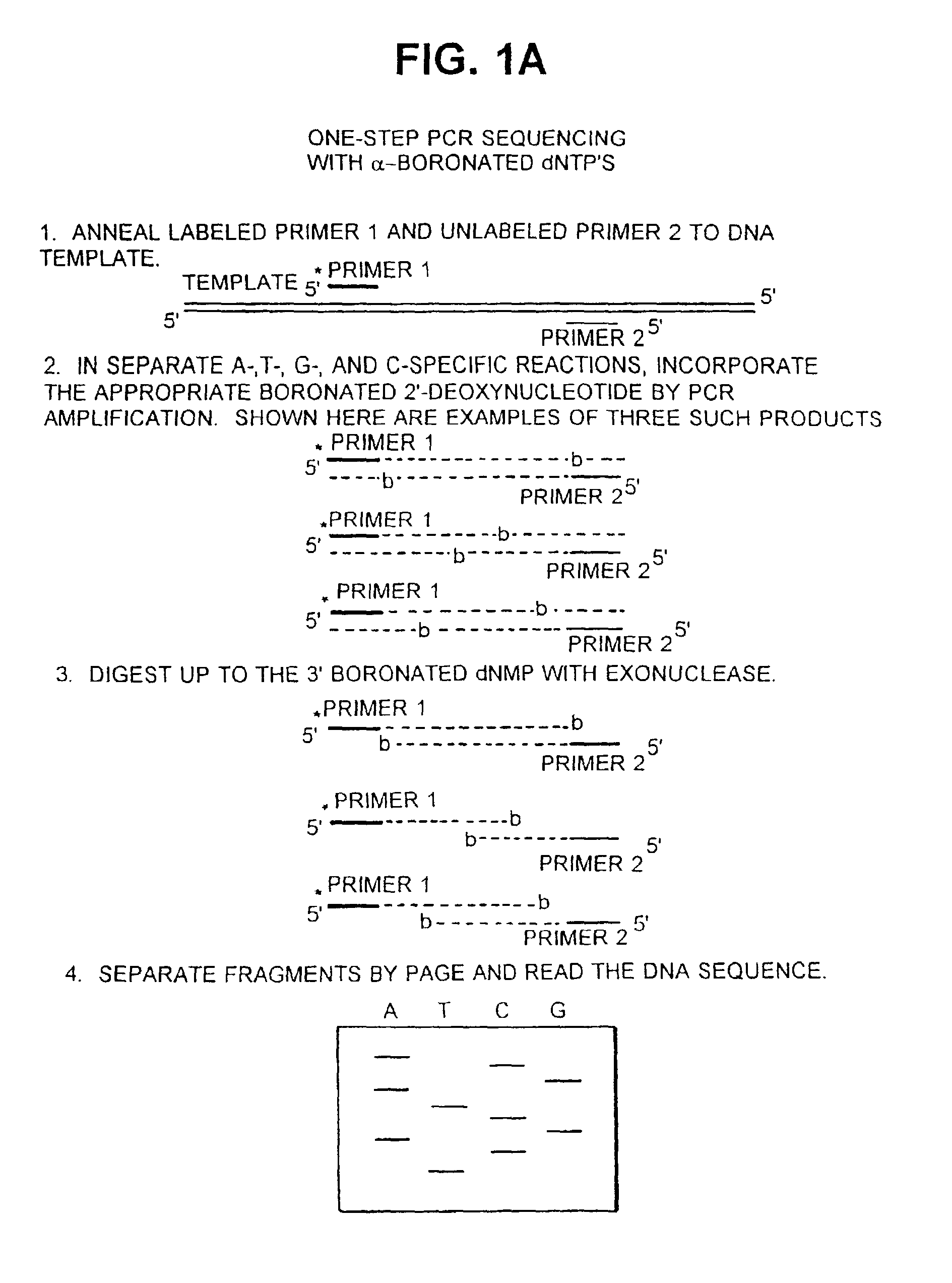Method of nucleic acid sequencing
a nucleic acid and sequencing technology, applied in the field of nucleic acid sequencing, can solve the problems of trying to combine the best features of both methods, pcr, sequence delimiters have proven unsatisfactory, method is fast and amenable to automation, etc., to increase the lifetime of injected dna, improve the effect of direct gene transfer method, and modulate the hormonal level of cardiac tissu
- Summary
- Abstract
- Description
- Claims
- Application Information
AI Technical Summary
Benefits of technology
Problems solved by technology
Method used
Image
Examples
example 2
Optimization of Incorporation of dNT.sup.bPs and Exonuclease Digestion
[0099] Optimization of reaction conditions (incorporation and digestion) results in a uniform and complete set of bands for each base-specific sequencing lane. Ideally, a single dNT.sup.bP is incorporated into each product molecule such that each position of the PCR product is represented equally. Exonuclease III digestion can be optimized so that each molecule is digested only to, and not beyond, the dNM.sup.bP.
[0100] A. Incorporation.
[0101] The incorporation efficiency (V.sub.max / K.sub.m) of each of the dNT.sup.bPs can be determined by kinetic analysis (Randall et al, J. Biol. Chem. 262:6864 (1987); Boosalis et al, J. Biol. Chem. 262:14689 (1987)). The kinetic parameters have been determined for a different type of boronated dNTP, the base-boronated N.sup.7-cyanoborane-2'-deoxyguanosi-ne 5'-triphosphate. For incorporation by exonuclease-free Klenow, it has been found that the base-boronated 2'-deoxyguanosine 5'-...
example 3
Amplification and Sequencing of Region of M13 mp2 Phage DNA
[0114] Materials:
[0115] The 2'-deoxynucleotides dA, dT, dC, and dG 5'-.alpha.-borano-thiotr-iphosphates were synthesized by the methods described in Tomasz et al, Angew. Chem. Int. Ed. Engl. 31:1373-1375 (1992)). Oligonucleotides were synthesized on an ABI 380B DNA synthesizer, purified by denaturing PAGE, and recovered by electroelution. The thermostable DNA polymerase, Vent, was purchased from New England Biolabs. M13 mp2 DNA was provided by Ted Gonzalez, Duke University. (Frederico et al, Biochemistry 29:2532 (1990)). .gamma..sup.33P-ATP (>1000 Ci / mmol) was purchased from Amersham.
[0116] Labeling of Primer 1:
[0117] Primer SS20 (5'-TATCGGCCTCAGGAAGATCG-3' complementary to positions 6467 to 6448 of M13 mp2; 20 pmol) was 5' end-labeled with .gamma..sup.33P-ATP (20 .mu.Ci) and polynucleotide kinase (New England Biolabs; 10 units) in the manufacturer-supplied buffer (10 .mu.l).
[0118] Polymerase Chain Reaction:
[0119] (+) M13 mp...
example 4
[0137] (A) Incorporation of Boronated Nucleotides in PCR Products and (B) Base Specific Resistance of Extended Primers to Exonuclease Activity
[0138] A. Incorporation of Boronated Nucleotides
[0139] Materials. The 5'-.alpha.-borano-triphosphates of dA, dT, dC, and dG were synthesized and the diastereomers were HPLC-separated by modifications of the methods described in Tomasz et al (Angew. Chem. Int. Ed. Engl. 31:1373 (1992)). Normal oligonucleotides to be used as primers were purchased from Genset, purified by TLC (USB), and recovered by lyophilization. The thermostable DNA polymerases, Vent and Taq, were purchased from New England Biolabs and Boehringer Mannheim. .gamma.-.sup.33P-ATP and .alpha.-.sup.33P-dATP (>1000 Ci / mmol) were purchased from Amersham.
[0140] Polymerase Chain Reaction. Phage T7 DNA template (5 ng) was mixed with 20 pmol primers (T7.sub.for: 5'-GGAGCGTAGGAAATAATAC-3' and T7.sub.rev:5'-CGGTTTTAATTACGTTAGCC-3'), dATP, dTTP, dCTP, and dGTP (100 .mu.M of each), and one ...
PUM
| Property | Measurement | Unit |
|---|---|---|
| concentrations | aaaaa | aaaaa |
| δ | aaaaa | aaaaa |
| δ | aaaaa | aaaaa |
Abstract
Description
Claims
Application Information
 Login to View More
Login to View More - R&D
- Intellectual Property
- Life Sciences
- Materials
- Tech Scout
- Unparalleled Data Quality
- Higher Quality Content
- 60% Fewer Hallucinations
Browse by: Latest US Patents, China's latest patents, Technical Efficacy Thesaurus, Application Domain, Technology Topic, Popular Technical Reports.
© 2025 PatSnap. All rights reserved.Legal|Privacy policy|Modern Slavery Act Transparency Statement|Sitemap|About US| Contact US: help@patsnap.com



